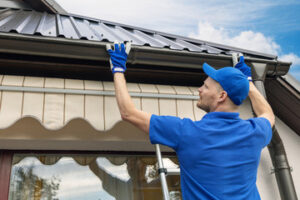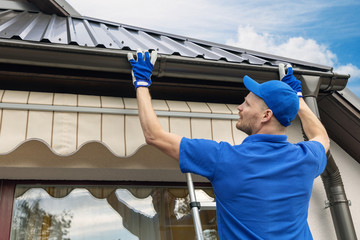Your roof is one of the most important parts of your home. Residential roofing repair protects everything inside your home and keeps you and your family safe. When your roof needs repair, you need a professional contractor. This is especially true if you live in an area with frequent storms.
 Gutters and downspouts are important to residential roofing as they help drain water away from your home. Rainwater can damage your landscaping, flood your basement and cause foundation problems. You could face expensive repairs if your gutters and downspouts are in poor condition.
Gutters and downspouts are important to residential roofing as they help drain water away from your home. Rainwater can damage your landscaping, flood your basement and cause foundation problems. You could face expensive repairs if your gutters and downspouts are in poor condition.
When a gutter system is working properly, it’s able to redirect rainwater and snowmelt from your roof safely. This is essential for the long-term health of your house. Without a properly functioning gutter and downspout system, your roof and walls may begin to decay. The water can also slowly erode your home’s foundation. A gutter system that has clogged downspouts can leave water pooling on your roof and around your house. This can erode your soil, flood your basement and cause cracks to develop in your home’s foundation.
The number of downspouts that you need depends on your roof’s pitch and the amount of water it collects during storms. In general, you should have one downspout for every 40 linear feet of gutter. If you have a steep roof or a large surface area, you should install more downspouts than this number. Your downspouts should be placed at least 30 inches from the ground to prevent water from pooling near your home.
Another important factor to consider when choosing a downspout is the material it is made of. The best choices are seamless aluminum or steel, as they’re durable and resistant to dents. There are also round downspout styles that have corrugations to conceal dents over time and offer additional strength. They are popular for upscale homes and restoration projects. These downspouts are usually made of metal and are available in many different colors and finishes. They are typically paired with box-style and k-style gutters.
Downspouts are one of the most overlooked components of a gutter system. They should be cleaned regularly, so they don’t become clogged and keep water from draining into your gutters. They also should be replaced if they become rusted or damaged, which can lead to leaking.
Shingles are one of the most common roofing materials for residential homes. They provide a number of benefits, including protection from weather damage and increased energy efficiency. They also look great and can add value to your home.
If your shingles are deteriorating or showing signs of wear and tear, it’s time to repair them. Fortunately, there are several ways to approach the job. First, determine the source of the damage.
Blistering, for example, is a common problem that contractors encounter. It occurs when moisture gets trapped between a shingle’s fiberglass backing, asphalt coating and granules on the top surface. Moisture can expand and pop out of the shingle, creating an exposed spot on the roof.
The best way to fix this problem is to remove the damaged shingle and replace it with another shingle. Use a hammer, flat pry bar or crowbar to carefully remove the shingle from the roof, pulling up at least five tabs in the second row above the damaged shingle (this will allow you to install the new shingle).
It’s also a good idea to re-seal the edges of all three shingles. This is done by lifting each tab slightly and applying a 1″ (2.5 cm) diameter spot of shingle cement under each tab. Once this is done, press the tabs down into the cement and secure the shingle in place.
Next, make sure all the nails that were attached to the shingle are removed. Then, re-install the shingle by pushing the tabs back into the cement and pressing them down firmly.
A re-roofing project can be tricky, so it’s important to choose the right contractor for the job. A professional will be able to identify any potential issues and get them fixed before they escalate into major problems.
When re-roofing, it’s also a good idea to assess your local code regulations for re-roofing. Some cities and states only allow a certain number of layers of roof shingles, so be sure to check with your jurisdiction before getting started.
Whether you’re replacing your entire roof or simply repairing one section, it’s always a good idea to check the manufacturer’s warranty for any issues that may arise. This can help you avoid costly repairs in the future.
Flashing is the material that protects the most vulnerable parts of your roof, such as skylights and vents. It also helps prevent leaks and moisture damage to your home. Without proper flashing, your home will suffer from mold and mildew, rotted wood and other problems that can be very costly to repair.
There are several different types of flashing, each designed to fit a specific purpose. Some are used to protect the perimeter of a building, while others are used to protect walls and chimneys.
A roofing contractor can install flashing in any area of your home where water is expected to travel through or around an opening, such as a skylight, chimney, or vent. Besides protecting the structure from water damage, flashing can help extend the life of your roof by keeping it from wearing down prematurely.
Some areas of the roof are more prone to leaking than others, such as valleys where two roof slopes meet. Because of this, flashing is usually installed at these locations.
The flashing material is made from a corrosion-resistant metal such as aluminum or copper. It is rolled out and then sealed so that it does not allow water to penetrate through the shingles.
During a roof inspection, your professional roofer will inspect the flashing to see if it is in good shape or needs repairs. If it is damaged, it will need to be repaired immediately to prevent water from causing serious damage to your home and to the rest of the building.
Your roofing contractor should be able to recommend the best type of flashing for your home. Some of the most common types of flashing include continuous flashing, through wall flashing, drip edge, and cap flashing.
Other types of flashing are concealed, such as sill flashing and channel flashing. These are typically concealed under window or door thresholds to prevent water from entering the structure through them.
Some other places where flashing is needed are at headwalls, where a roof meets a wall, and at any place that the roof’s continuity is penetrated or terminated. This includes any new vent pipes, roof drains, or skylights that are installed in a home.
Insulation is an important part of residential roofing repair. It keeps a home warm in the winter and cool in the summer, which saves homeowners money on energy costs. In addition, insulation can help prevent mold growth and insect infestations.
Roofing companies install various types of insulation on your roof, including foam board insulation, batts, and blown-in insulation. The type of insulation you choose depends on your budget and the type of construction in your home. The type of insulation you select also affects your roofing contractor’s work.
Polystyrene insulation, or expanded polystyrene (EPS), is a common form of foam board insulation. It is made from small plastic beads that are fused together. EPS can be cut to fit into roof deck spaces and other gaps on the exterior of your house. It is a good choice for homes in hot climates, since it does not absorb water like wood fiber insulation.
Closed-cell foam insulation is a good choice for your home in cooler climates. It is more dense than open-cell foam, and it provides better resistance against air and moisture.
Structural insulated panels, or SIPs, are another type of home insulation. These panels are constructed from foam boards that are bonded together, and they are then fastened to a building’s frame. These panels are usually 3.5 inches (89 mm) thick and can be used for ceilings as well.
The R-value of insulation is a measurement of the amount of heat that it can keep out of your home. The higher the R-value, the better it will insulate your home.
Batts are a popular choice for attic insulation, as they can be easily slid into any crack or crevice in your roof’s structure. They can be installed by squeezing them between the joists and studs of your roof’s framing, according to This Old House.
Alternatively, you can install roll insulation in the same way. You will need to determine the thickness and width of your home’s joists and studs before you begin installation. You’ll then need to cut the rolls to size as you place them in the joists and studs, according to Home Tips.


